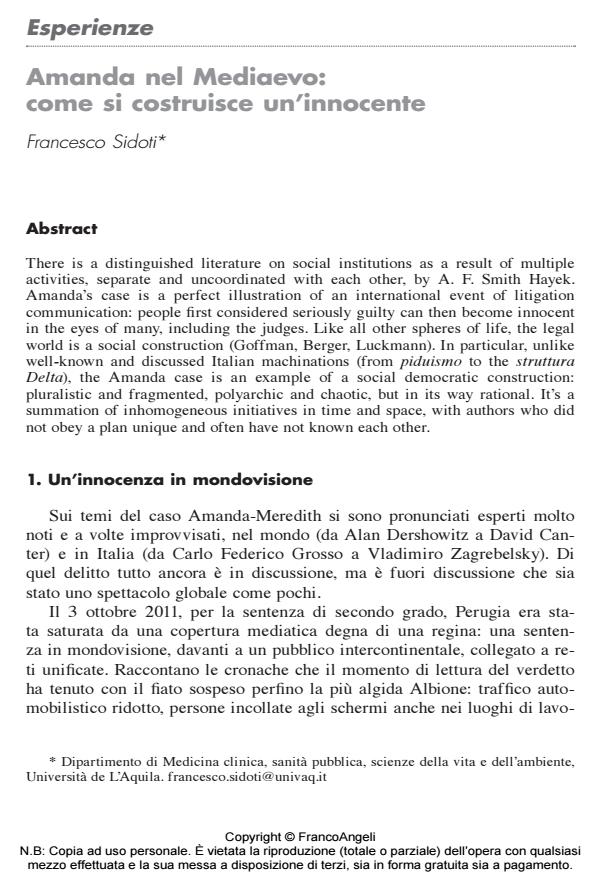Amanda nel Mediaevo: come si costruisce un’innocente
Titolo Rivista SICUREZZA E SCIENZE SOCIALI
Autori/Curatori Francesco Sidoti
Anno di pubblicazione 2013 Fascicolo 2013/2 Lingua Italiano
Numero pagine 13 P. 107-119 Dimensione file 259 KB
DOI 10.3280/SISS2013-002008
Il DOI è il codice a barre della proprietà intellettuale: per saperne di più
clicca qui
Qui sotto puoi vedere in anteprima la prima pagina di questo articolo.
Se questo articolo ti interessa, lo puoi acquistare (e scaricare in formato pdf) seguendo le facili indicazioni per acquistare il download credit. Acquista Download Credits per scaricare questo Articolo in formato PDF

FrancoAngeli è membro della Publishers International Linking Association, Inc (PILA)associazione indipendente e non profit per facilitare (attraverso i servizi tecnologici implementati da CrossRef.org) l’accesso degli studiosi ai contenuti digitali nelle pubblicazioni professionali e scientifiche
There is a distinguished literature on social institutions as a result of multiple activities, separate and uncoordinated with each other, by A. F. Smith Hayek. Amanda’s case is a perfect illustration of an international event of litigation communication: people first considered seriously guilty can then become innocent in the eyes of many, including the judges. Like all other spheres of life, the legal world is a social construction (Goffman, Berger, Luckmann). In particular, unlike well-known and discussed Italian machinations (from piduismo to the struttura Delta), the Amanda case is an example of a social democratic construction: pluralistic and fragmented, polyarchic and chaotic, but in its way rational. It’s a summation of inhomogeneous initiatives in time and space, with authors who did not obey a plan unique and often have not known each other.;
- AA. VV, La crescita delle litigation pr: il caso del processo di Perugia, in Relazioni pubbliche. Magazine della Federazione Relazioni Pubbliche Italia, 2011, 65.
- Dietrich H. (2011). Seattle PR firm reveals efforts to free Amanda Knox. Puget Sound Business Journal.
- Dolan M., Felch J. (2008). The danger of DNA: It isn’t perfect. Los Angeles Times, December 26.
- Entman R. M. (2004). Projections of Power: Framing News, Public Opinion, and U.S. Foreign Policy. Chicago: University of Chicago Press.
- Gammone M. a cura di (2008). Scienze dell’investigazione. Interventi di magistrati, avvocati, giornalisti, storici, criminologi, criminalisti, psicologi, sociologi, politologi, investigatori pubblici e privati. L’Aquila: Colacchi.
- Garrett B. L. (2011). Convicting the Innocent. Where Criminal Prosecutions Go Wrong. Boston: Harvard University Press. DOI: 10.4159/harvard.9780674060982
- Huizinga J. (1966). L’autunno del Medio Evo. Firenze: Sansoni.
- Kaplan A. (1964). The Conduct of the Inquiry. Methodology for the Behavioral Sciences. San Francisco: Chandler.
- Kaplan R.D. (2004). The Media and Medievalism. Policy Review, 128.
- Lupo E., Amodio E. (2009). Alla ricerca di linee guida affidabili per la motivazione concisa. Giustizia insieme, 2-3: 75-92.
- Melissen J. (2005). The New Public Diplomacy: Soft Power in International Relations. New York: Palgrave Macmillan. DOI: 10.1057/9780230554931
- Nadeau B. (2010). Angel Face: The True Story of Student Killer Amanda Knox.
- Sidoti F. (2006). Criminologia e investigazione. Milano: Giuffrè.
- Sidoti F. (2012). Il crimine all’italiana. Milano: Guerini.
Francesco Sidoti, Amanda nel Mediaevo: come si costruisce un’innocente in "SICUREZZA E SCIENZE SOCIALI" 2/2013, pp 107-119, DOI: 10.3280/SISS2013-002008